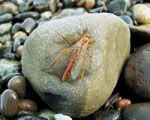Oregon Department of Fish and Wildlife
Contact: Anne Pressentin Young (503) 947-6020
Internet:
www.dfw.state.or.us Fax: (503) 947-6009
For Immediate Release Monday, March 01, 2004
First commercial spring chinook fishery to occur Tuesday on the
Columbia River
CLACKAMAS - The states of Washington and Oregon working as the Columbia
River Compact today authorized a 16-hour commercial gillnet fishery for
Tuesday in the lower Columbia River for hatchery-bred spring chinook. The fish caught by commercial boats in this fishery are prized for their flavor and will soon be found in local restaurants offering fresh local seafood and specialty markets. Spring chinook provide tremendous economic benefit to both the commercial and sport-fishing industries because of its high quality and because it is the first fresh non-farmed salmon of the season.
The commercial fishery will begin at 5 a.m. and conclude at 9 p.m. on Tuesday, March 2, from the mouth upstream to Kelley Point, which near the mouth of the Willamette River. Another 16-hour fishery may occur Thursday, March 4, depending on the results of tomorrow's fishery. A decision will be made at 1 p.m., Wednesday.
Commercial fishermen must use gillnets that have mesh openings no smaller than 9 inches and no larger than 9.75 inches to lessen the
chance that steelhead will be caught in them. Nets may not be in the
water longer than 45 minutes before being brought in the boat for fish removal. All fish that are not adipose fin-clipped spring chinook must be released. Boats must have a recovery box on board to revive all lethargic or bleeding wild salmon or steelhead before being returned to the water.
Fish biologists from the Oregon and Washington departments of fish and wildlife predict the total run of Columbia River spring chinook will be the second-highest since 1938, when counting began. About 500,000 wild and hatchery spring chinook are forecast to enter the Columbia River in 2004. Of the total run, 70-80 percent are marked by a missing adipose fin to designate them as "keepers." Biologists estimate a total mainstem harvest of about 50,000 hatchery-bred spring chinook, split between sport anglers and the commercial fishing industry.
Fish managers set the Columbia River spring chinook fishery based on the number of fish expected to return from the ocean and the allowable impact to wild salmon and steelhead stocks listed under the federal Endangered Species Act. "Impacts" are the unintended mortalities associated with handling and releasing wild fish. The allowed non-Indian impacts are 2 percent of the total runs of ESA-listed Snake River spring chinook, Upper Columbia River spring chinook, and Columbia Basin winter steelhead.
The total 2 percent allowable impact is split 1.2 percent to the sport
fisheries and 0.8 percent to the commercial fishers for the 2004-2005 fisheries.
Sport angling will continue during the commercial fishery.

















 Previous Topic
Previous Topic Index
Index

